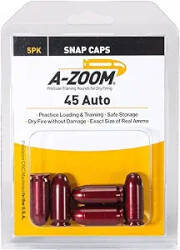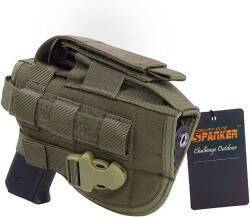
.45 ACP Ammo
Origins of the .45 ACP Cartridge
John Browning developed the .45 Automatic Colt Pistol cartridge in 1905. It was for the .45 caliber semi-automatic pistol Browning was designing for Colt. That pistol design eventually became the M1911 pistol which the U.S. Army adopted in 1911. The combination of the M1911 pistol and the .45 ACP round were designed in reaction to U.S. experiences against the Moro tribesmen, fanatical (and sometimes drugged) Moslem insurgents in the southern Philippines in a 14-year rebellion immediately following the ten-week Spanish-American War. The U.S. Army had mostly replaced the .45 Colt Single Action Army cartridge during the late 1890s. The Army standard sidearm was the M1892 Colt revolver firing the .38 Long Colt cartridge. The .38 caliber round wasn't effective, certainly not against the Moro, so a replacement cartridge and pistol were needed.
The Spanish-American War
The ten-week-long Spanish-American War began in early 1898 as a result of U.S. intervention in the Cuban War of Independence. U.S. President McKinley sent the USS Maine to Cuba to protect U.S. citizens and business interests after riots following the assumption of power by the Cuban autonomous government.
The Maine suffered a large explosion and sank on the evening of February 15, 1898, with 266 sailors killed. New York newspaper publishers William Randolph Hearst and Joseph Pulitzer published exaggerated and sensationalized reports of "Spanish atrocities" routinely committed in Cuba, of which the destruction of the Maine was obviously yet another example.
The initial U.S. Navy investigation concluded on March 28th that an external explosion under the ship's hull had ignited its powder magazines. The U.S. Congress passed a resolution on April 19th authorizing the President to use as much military force as he thought necessary to help Cuba gain its independence from Spain.
On April 21st, Spain severed diplomatic relations with the U.S. and the U.S. Navy began a blockage of Cuba. On April 23rd, Spain formally declared war on the U.S. On April 25th, the U.S. Congress formally declared that a state of war between the U.S. and Spain had begun on the 21st with the establishment of the blockade. "Ha! First!" the U.S. preëmptorily shouted as Spain cringed.
The first encounter between U.S. and Spanish forces was in the western Pacific, where Spain held colonies in the Philippines and Guam. Commodore George Dewey aboard the USS Olympia led the U.S. Navy's Asiatic Squadron. Germany had seized the Chinese port of Tsingtao in 1897, leaving the U.S. Asiatic Squadron at a logistical disadvantage. It was then the only naval force in the Far East without its own local base. However, within just a few hours on May 1st, the Asiatic Squadron destroyed the Spanish fleet in Manila Bay and captured the harbor. Dewey transported Emilio Aguinaldo, a Filipino leader of the rebellion against Spanish rule, from his exile in Hong Kong to the Philippines. On June 12, he declared Philippine independence.
The lack of telecommunications got in the way. A small U.S. fleet of just one armored cruiser and three transport ships entered Guam's harbor on June 20th and fired a few cannon rounds at Guam's Fort Santa Cruz. There was no response until two local Spanish officials approached the U.S. cruiser in a small boat and apologized for being out of gunpowder and therefore unable to respond to what they assumed was a salute. The U.S. commander explained to them that their countries were at war, the ineffective shots had been fired in anger, and they were seizing Guam.
Meanwhile in the Caribbean, there were land battles in Cuba and Puerto Rico, and naval operations around Cuba's port of Santiago de Cuba and Guantánamo Bay and a blockade of San Juan harbor in Puerto Rico.
Spain had been defeated on land and at sea in both its Caribbean and Pacific possessions. Spain sued for peace, and hostilities officially ended on August 12, 1898. Word didn't reach the Philippines immediately, as U.S. forces captured the city of Manila on August 13th. U.S. forces prevented Filipino forces from entering the captured city, and the resulting ill will led to the Philippine-American War.
The Treaty of Paris between the U.S. and Spain was signed in Paris on December 10th, 1898. This gave the U.S. all Spanish colonies outside of Africa, including the Philippines, Guam, and Puerto Rico. The 1903 Cuban-American Treaty gave the U.S. territorial control over the southern end of Guantánamo Bay.
The Philippine-American War and the Moro Rebellion
The Philippine-American War then began on February 4, 1899, and lasted until 1902. In parallel, the Moro Rebellion lasted until 1913. It was an armed conflict between U.S. military forces and the Moro or Bangsamoro, Muslim natives of the southern Philippines. The fighting took place on Mindanao, Sulu, and Palawan (or Minsupala) in the southern Philippines.
The Moro fighters were fanatical, sometimes fighting under the influence of drugs which dulled pain. The U.S. forces found that the .38 Long Colt cartridge just wasn't effective enough. A new pistol and cartridge were needed.

Browning had been working on a .41 caliber cartridge for Colt in 1904. That same year the U.S. Army conducted the Thompson-LaGarde Tests, run by Colonel John T. Thompson of the Infantry and Major Louis Anatole LaGarde of the Medical Corps. They conducted the tests at the Union Stock Yards in Chicago, shooting live cattle and human cadavers. Colonel John T. Thompson stated that the cartridge "should not be of less than .45 caliber" and "a real man-stopper." The pistol should be of semi-automatic operation capable of "well-directed rapid fire."
The following year, 1905, the U.S. Army asked for a .45 caliber design. Browning and Colt's prototype .41 caliber cartridge was scaled up to .45 and the pistol design was modified to fire it. The result was the .45 ACP cartridge and the Colt Model 1905 pistol.
M1911 / M1911A1Automatic Pistol
That combination was one of six submissions to the Army in 1906. A number of modifications were implemented over the following years, leading to the adoption in 1911 of the "Cal. .45 Automatic Pistol Ball Cartridge, Model of 1911."
Cal. .45 Automatic Pistol Ball Cartridge, Model of 1911
The resulting cartridge is 1.273 inches or 32.3 mm in length, with a 230 grain or 15 gram bullet. The standard Army load propelled it at 830 feet/second or 250 meters/second, for an energy of 477 Joules or 352 foot-pounds.
Remington's cartridge with an FMJ or full metal jacketed bullet has ballistic characteristics essentially identical to the military spec, as do Remington's and Federal jacketed hollow-point rounds.
The speed of sound at 32°F or 0°C is 1087 feet/second or 331 meters/second. So, the military loading is subsonic. The muzzle flash and recoil are moderate given the caliber.
SAAMI (or the Sporting Arms and Ammunition Manufacturer's Institute) limits the pressure for the .45 ACP cartridge to 21,000 psi or 140 MPa piezo pressure.
NRA lobbying has ensured that firearms and ammunition specifications and performance are not overseen by the Consumer Product Safety Commission or any other US government agency. SAAMI's guidelines are simply guidelines and they only apply to manufacturers that are members of SAAMI.
The European equivalent, the CIP or Commission Internationale Permanente pour l'Epreuve des Armes à Feu Portatives, the Permanent International Commission for Testing Portable Firearms, imposes a slightly lower pressure limit of 130 MPa or 19,000 psi.
Both these limits are well below those for other pistol cartridges, such as 35,000 psi for 9mm Parabellum, 37,500 for 10mm Auto, and 40,000 psi for .357 SIG.
These pictures show cartridges with both non-reloadable aluminum cases and with brass cases. The brass-cased cartridges seen here and elsewhere have red laquer seals on their primers. You can also see a thin band of red laquer sealing the bullet to the mouth of the case in the picture here. Some of the solvents and lubricants use to clean and protect guns can damage or otherwise disable primers and propellants. Lacquer sealants can protect ammunition.


The non-reloadable aluminum ones, with "N R" on their headstamp, are the low-cost Blazer line from CCI.
CCI or Cascade Cartridge Incorporated is based in Lewiston, Idaho. CCI is now a subsidiary of Alliant Techsystems, who in June 2009 won a US$ 14 million contract to provide their Speer GoldDot 9mm ammunition to all 250,000 police officers plus the national French Gendarmerie, French Customs, and the French corrections system.
As they describe on their Blazer web site, the case is the most expensive component of any cartridge. Aluminum reduces the cost, although it can't be safely reloaded as brass can.
The brass cased cartridges shown here are from Sellier & Bellot, a manufacturer founded by a French merchant in 1825. Louis Sellier began by manufacturing percussion caps in a factory in Prague for Francis I, the Emperor of Austria. Fellow Frenchman Jean Maria Nicolaus Bellot soon joined the company, and by 1830 they were a major ammunition manufacturer for European and overseas markets.
By 1837 they were manufacturing 156 million percussion caps per year. In 1870 they began manufacturing cartridges. Once World War I was over and the new country of Czechoslovakia was formed, Sillier & Bellot was the main supplier of handgun ammunition for the Czechoslovak Army and police.


Sellier & Bellot is now based in Vlašim, Czech Republic. They were acquired by the Brazilian company CBC, Companhia Brasileira de Cartuchos, in 2009. CBC is now one of the largest ammunition manufacturers in the world, based in São Paulo.
" Snap caps" or dummy ammunition cartridges like those shown below are useful for safe practice "dry firing" — cycling the action, aiming the weapon, and pulling the trigger with nothing but inert rounds.
The "primer" in a "snap cap" is made from soft plastic and is backed by a spring. Alternatively, some dummy ammunition is made entirely from soft plastic.
Either way, this brings the firing pin to a controlled stop. This prevents the firing pin from repeatedly striking against steel in the bolt face and work-hardening.






